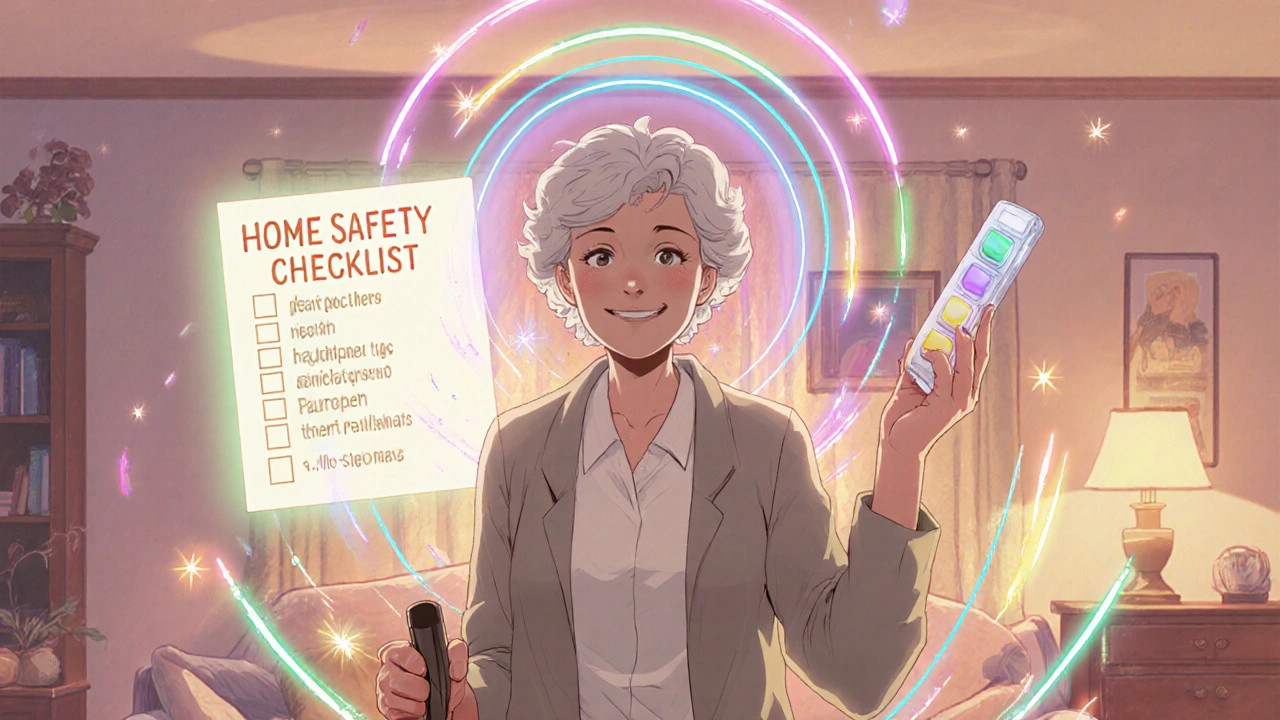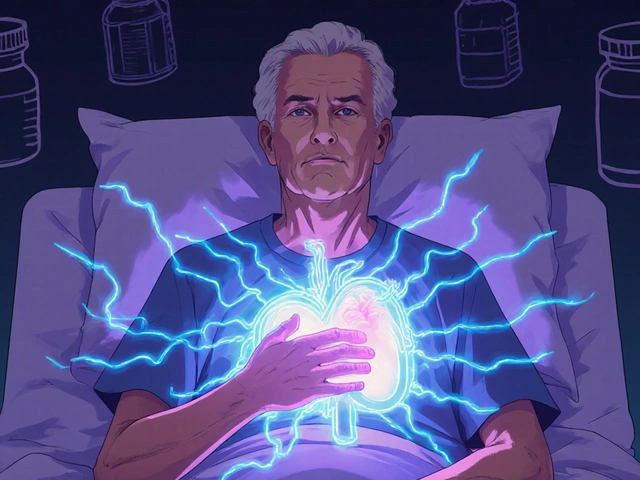Falls vs. Stroke Risk Calculator
Understand Your Risk Balance
The article explains that fall risk alone is not a good reason to stop blood thinners. This calculator shows the math behind why stroke prevention is often more important than bleeding risk from falls.
Stroke Risk
Per year
Bleeding Risk
Per year
Result: Your stroke risk is higher than bleeding risk from falls.
According to the article, you'd need to fall 295 times per year for bleeding risk to outweigh stroke prevention benefits. Most people fall 1.5 times per year.
What This Means For You
Based on your inputs, continuing your anticoagulation therapy is likely the safer choice. The article emphasizes that fall risk alone should not be a reason to stop blood thinners.
- DOACs are recommended over warfarin for people at risk of falls because they reduce brain bleeding risk by 30-50%.
- Your doctor should review your medications to reduce unnecessary fall risks.
- Focus on fall prevention: exercise, home safety, vision checks, and proper footwear.
Many older adults on blood thinners are told to stop taking them because they’re at risk of falling. But here’s the truth: fall risk alone is not a good reason to skip anticoagulants. In fact, stopping them because you’ve had a few tumbles could put you at far greater risk of stroke - a risk that’s much more likely to kill you than a fall ever will.
Why Falling Doesn’t Mean Stopping Blood Thinners
It’s a common fear: if you fall while on a blood thinner, you’ll bleed out. It sounds scary, and it’s why many doctors, family members, and even patients assume it’s safer to stop the medication. But the numbers don’t back that up. A person with atrial fibrillation and a CHA₂DS₂-VASc score of 3 (which is common in people over 70) has a 3% chance of having a stroke each year. That’s 30 out of every 1,000 people. If they’re not on anticoagulants, that risk stays high. Now, what’s the chance they’ll have a brain bleed from a fall while on a blood thinner? Around 0.2% to 0.5% per year. That’s 2 to 5 out of every 1,000. Here’s the math that flips the script: you’d need to fall 295 times in one year for the bleeding risk to outweigh the stroke prevention benefit of warfarin. Most people don’t fall that often - even in nursing homes, where falls are common, the average is 1.5 to 2 falls per person per year. That’s nowhere near 295. Professional guidelines from the American College of Physicians, the American Heart Association, and the European Society of Geriatric Medicine all agree: fall risk should never be the reason to withhold anticoagulation. The only real reasons to avoid blood thinners are active bleeding, uncontrolled high blood pressure (systolic over 180), or a known bleeding disorder.DOACs Are the Better Choice for Fall Risk Patients
If you’re on a blood thinner because of atrial fibrillation, you’re likely on either warfarin or one of the newer drugs called DOACs - direct oral anticoagulants. These include apixaban, rivaroxaban, dabigatran, and edoxaban. DOACs are now the first-line choice for most patients. Why? Because they’re safer. Compared to warfarin, DOACs reduce the risk of brain bleeding by 30% to 50%. They don’t need regular blood tests. They interact with fewer foods and other medications. And they’re just as good - if not better - at preventing strokes. For someone who’s prone to falls, this matters. A fall that causes a brain bleed on warfarin is more likely to be deadly than one on a DOAC. That’s why DOACs are used in about 80% of new anticoagulant prescriptions in the U.S. today. Don’t fall for the myth that lowering the DOAC dose makes it safer. Some doctors try to cut the dose to reduce bleeding risk. But research shows this doesn’t help - it just makes the drug less effective at preventing strokes. Stick to the standard dose unless your kidney function is severely impaired.How to Assess Fall Risk - the Right Way
You don’t have to live in fear of falling. You can reduce your risk - and keep taking your blood thinner safely. Start with a comprehensive fall risk assessment. This isn’t just about saying, “I’ve fallen before.” It’s about digging into the real causes:- Medications: Are you taking sedatives, sleeping pills, antihypertensives, or antidepressants? These can make you dizzy or slow your reflexes. A pharmacist or doctor can review what you’re on and cut unnecessary ones.
- Gait and balance: The Timed Up and Go test is simple - time how long it takes to stand from a chair, walk 3 meters, turn, walk back, and sit down. If it takes more than 12 seconds, you’re at higher risk.
- Vision: Outdated glasses? Cataracts? Poor vision is a top cause of falls. Get your eyes checked yearly.
- Home hazards: Loose rugs, poor lighting, cluttered hallways, no grab bars in the bathroom. These are fixable. A home safety visit from an occupational therapist can cut fall risk by up to 40%.
- Orthostatic hypotension: Does your blood pressure drop when you stand up? This causes dizziness. It’s common with age and certain meds. A simple test - lying down, then standing - can catch it.
What to Do After the Assessment
Once you know your risk factors, you act. Here’s what works:- Deprescribe: Stop drugs that aren’t needed. For example, if you’re on a sleeping pill you’ve taken for 10 years, it might be time to quit. Withdrawal can be done safely with support.
- Exercise: Strength and balance training - like tai chi or physical therapy - reduce falls by 25% to 35%. Even 20 minutes a day, three times a week, helps.
- Footwear: Wear non-slip shoes with good support. No slippers, no socks on hardwood.
- Assistive devices: If you need a cane or walker, use it. Don’t be proud. A fall with a walker is better than a fall without one.
- Supplements: Vitamin D (800-1,000 IU daily) improves muscle strength and balance in older adults. Many are deficient.
When Anticoagulation Might Not Be Right
There are exceptions. For some people, the risks do outweigh the benefits - but it’s not because they fall. If someone is very frail, has advanced dementia, and a life expectancy under one to two years, the long-term benefit of stroke prevention may not matter. A stroke that happens in the last months of life might not change outcomes much. In those cases, shared decision-making is key. Talk about goals: Do you want to live longer? Or avoid hospital trips and invasive treatments? But for most people - even those who’ve fallen before - the answer is still: keep the anticoagulant. Especially if your CHA₂DS₂-VASc score is 2 or higher (men) or 3 or higher (women). That’s moderate to high stroke risk. The math is clear.
What Happens If You Stop
Stopping anticoagulants because of fall risk doesn’t make you safer. It just changes the kind of danger you face. A study showed that older adults who stopped their blood thinners due to fall risk had a 50% higher chance of having a stroke - and those strokes were often more severe. The risk of death from stroke is higher than the risk of death from a fall-related bleed. And here’s the kicker: once you stop, it’s hard to restart. Many patients never get back on, even when their fall risk improves. That means years of unnecessary stroke risk.What You Can Do Today
If you or a loved one is on a blood thinner and worried about falling:- Check your CHA₂DS₂-VASc score. If it’s 2+ (men) or 3+ (women), you’re at moderate to high stroke risk - and you should be on a blood thinner.
- Ask your doctor: “Am I on a DOAC? If not, should I switch?”
- Request a fall risk assessment. Don’t wait for them to bring it up.
- Review all your medications with a pharmacist.
- Start a simple balance routine - stand on one foot while brushing your teeth, or do heel-to-toe walks down the hallway.
- Remove trip hazards at home. Install grab bars. Turn on nightlights.
Frequently Asked Questions
Should I stop my blood thinner if I’ve fallen once?
No. A single fall doesn’t mean you should stop anticoagulation. The risk of stroke without a blood thinner is much higher than the risk of a serious bleed from one fall. Focus on finding out why you fell and preventing the next one.
Are DOACs safer than warfarin if I fall a lot?
Yes. DOACs reduce the risk of brain bleeding by 30% to 50% compared to warfarin. They’re also easier to manage - no regular blood tests, fewer food interactions, and more predictable effects. For people with fall risk, DOACs are the preferred choice.
Can I lower my DOAC dose to reduce bleeding risk?
No. Reducing the dose of a DOAC doesn’t lower bleeding risk significantly - it just makes the drug less effective at preventing strokes. Stick to the prescribed dose unless your kidney function is severely impaired.
What’s the best way to prevent falls at home?
Start with the basics: remove loose rugs, install grab bars in the bathroom, improve lighting (especially at night), wear non-slip shoes, and get your vision checked. A home safety assessment by an occupational therapist can cut fall risk by up to 40%.
Is it safe to take blood thinners in a nursing home?
Yes. Even though over half of nursing home residents fall each year, guidelines strongly recommend continuing anticoagulation if stroke risk is moderate to high. The focus should be on improving safety - not stopping the medication. Many facilities now use interdisciplinary teams to assess and reduce fall risk while keeping anticoagulation.





Josh Evans - 30 November 2025
I used to think stopping blood thinners after a fall was the safe move-until my dad had a stroke last year. He’d been off warfarin for six months ‘just to be safe.’ Turned out, he didn’t even remember falling. Just woke up with half his body gone. DOACs saved his life after we switched him. Don’t let fear make you stupid.
Allison Reed - 1 December 2025
This is such an important post. So many families panic when Grandma stumbles and think ‘blood thinner = danger.’ But the real danger is the silent stroke that comes without warning. You can fix a fall. You can’t fix a brain that’s been starved of oxygen for 10 minutes. Keep the meds, fix the home, get moving. You’ve got this.
Jacob Keil - 3 December 2025
they tell you to take blood thinners but they dont tell you the pharma companies make more money off doacs than warfarin so its all a scam. the real reason they push doacs is because theyre expensive and dont need monitoring. they dont care if you bleed they care if you buy more pills. also falls are natural the body knows when its time to go
Rosy Wilkens - 3 December 2025
Have you considered that this entire narrative is being pushed by the American Medical Association to justify the overprescription of anticoagulants? The CDC has data showing that stroke mortality rates have been declining since 2010-yet DOAC prescriptions have skyrocketed. Coincidence? Or a calculated move to monetize aging? I’ve seen patients on three different anticoagulants simultaneously. This isn’t medicine-it’s a revenue stream.
Andrea Jones - 4 December 2025
Okay but can we talk about how ridiculous it is that doctors don’t even offer fall assessments? My mom fell twice and the doc just said ‘maybe stop the pill.’ No questions about her meds, no gait test, no grab bars suggested. Like, we’re supposed to just accept that as care? You’re not helping by being scared-you’re helping by being smart. Ask for the assessment. Demand it.
Justina Maynard - 6 December 2025
Let’s be real-fall risk isn’t the enemy. The enemy is the myth that aging means you’re just a walking liability. My aunt’s been on apixaban for 4 years, uses a cane, has nightlights in every room, and does tai chi three times a week. She’s sharper than half the people in her book club. You don’t survive old age by hiding. You survive it by outsmarting it. And yes, that includes keeping your blood thinner.
Evelyn Salazar Garcia - 7 December 2025
Stop the meds. Falls are rare. Strokes are common. But hospitals are profit machines. You’re being manipulated.
Clay Johnson - 9 December 2025
The math is clear. But the human mind isn’t wired for statistics. We fear the visible-blood on the floor-not the invisible-clot in the brain. That’s why we choose the wrong safety. Fear is louder than facts. But facts don’t care how loud you scream.
Jermaine Jordan - 10 December 2025
THIS IS THE MOST IMPORTANT HEALTH MESSAGE OF OUR TIME. I’ve watched three grandparents die from strokes they could’ve avoided. One of them cried the night before she had her stroke-she’d stopped her pill because she was ‘too clumsy.’ She didn’t even get to say goodbye. Don’t let fear steal your future. DOACs. Balance training. Home safety. That’s your trifecta. Fight for it.
Chetan Chauhan - 10 December 2025
u r wrong. in india we dont even have doacs. warfarin is all we got. and people fall all the time. but they live. maybe u r overestimating risk. maybe u r just scared of death. maybe the real problem is u r not used to aging. in my village, old people fall every day. they dont take pills. they live longer.
Phil Thornton - 11 December 2025
My uncle stopped his blood thinner after one tumble. Died six months later from a stroke. No drama. No warning. Just gone. Don’t be that guy.
Pranab Daulagupu - 12 December 2025
DOACs are superior in pharmacokinetics and have lower intracranial hemorrhage rates. The CHA₂DS₂-VASc score is validated across populations. Fall risk mitigation via environmental and pharmacological interventions is evidence-based. Prioritize modifiable factors over discontinuation.
Barbara McClelland - 13 December 2025
Love this so much. My mom’s on apixaban and we started doing chair yoga with her every morning. She says it’s her favorite part of the day. She’s not scared anymore. She’s strong. And she’s alive. That’s the win. Don’t let fear win for you.
Alexander Levin - 14 December 2025
They’re lying. The real reason they don’t want you to stop is because they’re testing new bleeding algorithms. You’re a lab rat. 🤖
Travis Freeman - 15 December 2025
I’m from the Philippines and we don’t have easy access to DOACs. But my 82-year-old uncle has been on warfarin for 8 years. He fell three times last year. No brain bleed. He walks with a cane, has handrails everywhere, and eats his veggies. He’s still planting mango trees. The body adapts. The fear doesn’t have to win.